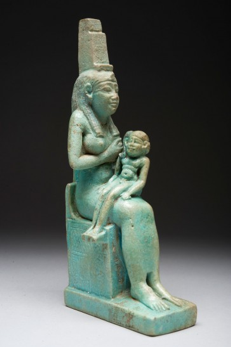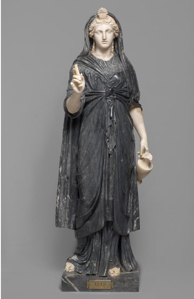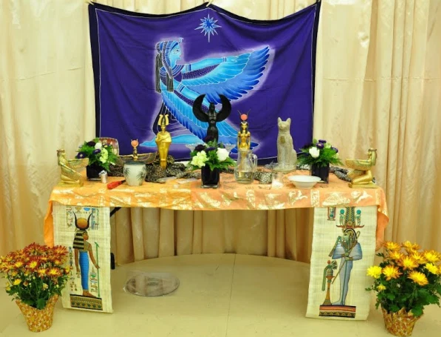Podcast: Play in new window | Download
Subscribe: Apple Podcasts | RSS
We discuss how the goddess Isis has changed throughout time from when she was first created in ancient Egypt to nowadays where she is still revered by some in the world.

1st Year Undergraduate

Transcript
[Introduction-0:00]
Gabriela Ramirez:
Thank you for tuning in. My name is Gabriela Ramirez and you’re listening to Season Two, Episode Four of Now as Then, where we discuss the ways in which Ancient Egypt has changed the different aspects of our culture in our world today. In this episode, the purpose of Isis, we’re going to discuss how the goddess Isis has changed throughout time from when she was first created in ancient Egypt to nowadays where she is still revered by some in the world. The Cult of Isis still exists today.
GR:
So what is it about this goddess that makes her so famous? Even most people who don’t revere her in any way, know who she is, and know that she has some connection to Ancient Egypt. Even some know that she’s an Egyptian goddess. But what is it about her that makes her so popular? We find out that throughout history she has been worshipped by many, but she has not always retained the same meanings that she has had from ancient Egypt. So let’s dive into the original meanings of Isis from ancient Egypt when we first hear about her purpose there.
[Section 1: Isis in Ancient Egypt-1:46]
GR:
In ancient Egypt, when we learn about Isis, she has very much taken on the role of a mother goddess and wife to Osiris. She is specifically the mother of Horus, and in The Contendings of Horus and Set, she helps her son become the ruler of the gods and goddesses, cradling him like a baby, though there are two main forms of Horus, Horus the younger and Horus the elder. (If you would like to learn about the different forms and popularity of Horus, check out Season One, Episode Four: Falcons and Pharaohs.) In fact, some figurines of Isis are of her cradling the baby Horus and nursing him. One such figurine can be found at the John Hopkins Archaeological Museum. It has a turquoise color, and you can tell that it is Isis by the symbol that is on her hair, the “chair” symbol. She holds Horus near her breast so that she can feed him. This image of Isis cradling baby Horus speaks to her qualities as a mother: caring, protective and supportive. (If you’d like to learn more about the image of Isis nursing baby Horus, check out Season One, Episode Five: Like a Virgin: Madonna and Child.) Thus, the Egyptians viewed her in the same way, a mother, asking her for guidance and protection, just like how she did for Horus and his troubles. Here’s Jordan Galczynski, a graduate student at UCLA, with more information on the topic.
Jordan Galczynski:
I think often Isis gets kind of equated with motherhood and you know, childbirth and like the protective mother. So I think that’s often especially later on in Egyptian history she gets she gets the mother kind of signal. Earlier on, I mean, she has like the kind of regenerative aspects to with putting together Osiris and then making the first Horus. So she was very integral in starting kingship in ancient Egypt. But yeah, I think most cases it’s she’s connected to motherhood, children. Protection things like this.
GR:
So even though Isis possesses different qualities and grander powers, such as the power of regeneration, the Egyptians considered her a mother goddess, having all of the qualities of a mother and protecting Ancient Egyptians like her children.
[Section 2: Isis in Greco-Roman culture-4:20]
GR:
When foreigners began to invade and travel to Egypt, the Egyptian culture became syncretized into other civilizations, especially Greek and Roman cultures. In some cases, some Egyptian gods and goddesses were forgotten. However, Isis did not die so easily like the others. With a strong Greek influence in Egypt, especially in the Delta region, many of the Greeks began to syncretize, or merge, Isis into their culture, even along with their own gods and goddesses. Oftentimes, the Greeks would compare her to Aphrodite. It is very interesting that she would be compared to Aphrodite given her role in ancient Egypt was a mother goddess. Aphrodite does not necessarily possess motherly qualities. In fact, she is vain about her own beauty. However, the Greeks compared Isis to the fertility aspects of Aphrodite since Isis impregnated herself when she regenerated Osiris from the dead. The comparison between Aphrodite and Isis possibly gives the latter a new purpose as a goddess of fertility. Though it is not a very popularized idea, there are still some who compare Isis to Aphrodite for this purpose. However, Isis was syncretized into Greek mythology in another somewhat unusual way. There were some Greeks who believed that Isis was the goddess of the seas. Now, in Greek mythology, it’s Poseidon who’s the god of the seas; this could possibly be another connection to Isis as possible, grander powers. According to the 2019 book Isis Pelagia: Images, Names and Cults of a Goddess of the Seas, it says that “the Egyptians perceive the seas as frightening, a place where there are risks that can lead to capsizing or even death.” Even if the Egyptians did not value the seas, the Greeks definitely did as they built their entire culture around the Mediterranean Sea. So, because the Greeks began to perceive, through Egypt secretization, how much power Isis could have, they believed that her power must be demonstrated through the power of the waves. Therefore, to some cults of Isis in Greece, Isis’s purpose was to be the goddess of the seas, praying to her to keep them safe as they cross the seas as a sign of her power. It is very different from the purpose of a mother goddess.
GR:
Across the “pond” in Rome, Isis gained huge popularity than she ever had before. There she was so absorbed into Roman culture that she was considered an All-Goddess, a goddess with so much power that she had powers from most of the other deities in Roman mythology. According to the 2016 book, ISIS: Eternal Goddess of Egypt and Rome, some Romans viewed her as a savior “as she eventually becomes a beneficial goddess of nature, a saviour, and to many, the sole goddess.” Again, the savior purpose appears in the Roman culture, attributing to her great power and many Romans believed that she was so much more powerful than the other Roman deities that they worshipped Isis more. Their worship was so great that they began to build temples and statues for her. The Art History Museum in Vienna, Austria, in the Collection of Antiquities, there’s a statue of Isis from Roman culture, and it’s from the Middle Imperial period from the first half of the second century CE; it was found in Naples, Italy. Now this statue has some Egyptian culture on it, like the broken sistrum in her right hand or the jar of the holy Nile water in her left hand, or maybe the headdress of the sun disk, between cow horns, borrowed from the ancient Egyptian goddess, Hathor. The main difference is she is dressed in Roman garments, specifically black Roman garments. In the description of the statue, the dark parts of the robes are meant to contrast against the “white marble of the incarnate of the goddess” to demonstrate her purity. This statue is a great representation of Isis’s popularity among the Romans, and her popularity swept over the entire Roman Empire and remained there for many more decades. Jordan has more to add about Isis’s popularity in Rome.
JG:
I think specifically of the Romans, adopt the Cult of Isis and bring the cult back to you know, the Italian peninsula. So you find we find temples dedicated to Isis in Pompei. You can there’s one, there’s one in Rome. We have people being you know, priests of Isis, Italians, Romans. Even stories The Golden Ass, The Metamorphosis is a story about a individual a Roman going trying to initiate into the Isis cult, and all the mysteries that and you know is part of this.
GR:
The mystical and exotic aspect of Isis being from ancient Egypt, also very much appealed to the Romans. The main significance here of Isis from the Greeks and the Romans is that to them, she was not a mother goddess. To some Greeks, she was a powerful goddess, the goddess of the seas. Although it definitely surprised me, I can see why they viewed her as a goddess of the seas, due to her power and connection to water from two very different civilizations. The Greeks knew that they had to appeal to her for safe passage on the seas. Then we move on further to Roman culture, and she’s seen as an All-Goddess, almost as if she was monotheistic, even though some Romans were still polytheistic and did worship the other gods and goddesses. But they were many, many Romans who saw her as a generic, mystical, All-Goddess with a lot of power to bring salvation to them. It was very different from her role as a mother goddess, someone who would protect the Egyptians.
[Section 3: The Disappearance of the Cult of Isis’s Popularity-11:33]
GR:
As I continued my research, I noticed that I could not find sources that stated she was very popular during the Middle Ages or the Renaissance era. And I think the reason for this has to do with the rising popularity of Christianity. Here’s what Jordan says about the popularity of Christianity and how it affected Cults of Isis at the end of the Roman Empire.
JG:
I think just like, you know, Christianity being so popular and you can’t, you know, in Christian thought you there’s one god right you can’t worship other gods. So the popularity of Christianity and in being Christian at least in, you know, Europe and such, takes over. Even in Egypt right we have there they convert very quickly to Christianity so I just think yeah the popularity of monotheism right. monotheistic religions during the time take over.
GR:
Sometimes some Christian officials would take brutal ways to stop people from worshipping polytheistic religions. Those who are found worshipping another god, or pagans, were put to death. So someone who was worshipping Isis would have most likely stopped. However, this does not mean that the Cult of Isis died off. In fact, the Cult of Isis has been found in some unusual places.
[Section 4: Isis in Modern Times-13:05]
GR:
So let’s move on further in time and go to County Wexford in Ireland in 1994. An article was published in the National Catholic Reporter called “Goddess Isis alive and well in County Wexford.” Now, you might be probably thinking, “Wait, isn’t Ireland predominantly Catholic?” And this article implicitly asked the same question as well. The article asserts that even in Catholic Ireland, the cult of Isis is very popular. It addresses how the first appearance of the cult of Isis was in 1976, 18 years before the publication of this article. It even shows a picture of Isis in the Huntington Castle temple. Olivia Robertson and the Reverend Lawrence Durdin-Robertson “launched the fellowship of Isis” which praised Isis for her feminine divinity, especially since they needed a powerful “female spirituality” against the “men who have been messing up the world.” They found Isis so that they could have some connection to divinity to help them out. This was in the 1970s 1980s, where the goddess Isis is still very much popular, possibly even due to Egyptomania, the renewed interest of Europeans in ancient Egypt, with, yet again, another different purpose for the goddess Isis, and her popularity continues even into the 21st century. In an article called Isis & Secret Magic & Esoteric Books, by Isidora from the website Isiopolis, a website dedicated to the goddess Isis, there is a picture of what a modern-day altar of Isis would look like. The modern altar of Isis of the fellowship of Isis in Utah has a little Isis figurine in the center with her wings expanded outwards and upwards to show the full length of her power. Surrounding her are other little figurines and some flowers, one of the other figurines being Osiris. Behind her, there’s a tapestry of Isis, laying on her side and her wings spread out. Here, Isis is a magician goddess. This ability actually comes from some evidence of it in ancient Egypt, and it was not as known as her role as a mother goddess. However, some current Fellowships of Isis “understood magic to be inseparable from a relationship with Isis, the Goddess of Magic … from the compassionate magic of healing to the ecstasy of the theurgic union that renews the spirit and deepens the soul.” Isis now has a new purpose, Isis as the goddess of magic, magic that is used to heal. Now, this is a different purpose than what we have seen; before, she was powerful, a mother, purely divine. Now, she is a magician but most of all, a healer. Many people can speculate about why, in modern times, people want to see her as a magic healer, done through compassion. One speculation, and again, it is a speculation, is that through all the war and suffering we have been through, some people wanted a little compassion in the world.
[Section 5: Isis Commercialized in Popular Media-16:53]
GR:
Though the Cults and Fellowships of Isis are popular in modern times today, there are many people who don’t worship her but still use the aesthetic and some understanding of Isis to commercialize her meaning. For example, in 2014, Katy Perry released a music video to her single “Dark Horse” featuring Juicy J. Towards the end of the music video, around three minutes, Katy Perry begins to ascend the pyramid that she received as a gift, demonstrating her power, but at around three minutes and 20 seconds, she begins to pull these wings from behind and strongly hold them out as she continues to sing, and the song begins to finish. These images are the same as the images of Isis on a modern altar. Even before this moment in the video, she says she is Aphrodite, provoking the comparison of Isis to Aphrodite. Afterwards, I found another video titled “Katy Perry’s ‘Dark Horse’ Behind the Scenes” to see if there was any reason for why she chose to be Isis at the end of the music video. Although she did mention the parts about her being Isis, she didn’t give any explanation for this choice. So, I must speculate if the use of Isis is a part of ancient Egyptian commercialization, or using images of ancient Egypt for someone’s profits. Like I mentioned before, not many people know much about the goddess Isis. Then, could it be that Katy Perry was commercializing the way Isis looked like so that she could appeal to those who might recognize that she was trying to look like Isis? She would not just be commercializing Isis, but all of ancient Egypt. She compared herself to Cleopatra as well, and there are various images of Egyptian gods and goddesses that would be in ancient Egyptian tombs. She uses the aesthetic of ancient Egypt as background to what her song is really about: telling a lover not to mess with her. Here’s what Jordan says about possible commercialization in “Dark Horse.”
JG:
I think they’re harkening back to these images we have from either bright spreading her wings being like a vulture Goddess, right, of like protecting. So I think they’re definitely pulling on these metaphors that the Egyptians would recognize today if they saw Katy Perry’s music video, but then to the Egyptians, right. This stuff was supposed to be you know, not shown to the public, maybe kept in a tomb, kept in the temple, in like a very sacred space and not for you know, popular media or something like this. So I think the Egyptians would be like, you’re blaspheming like the goddess right? So I think they would recognize the artistic metaphors being used right? Like recall Isis her, her headdress, maybe her garb, the wings and stuff like this. But I don’t think they would acknowledge how she’s being used I guess in this commercialization sense of like harkening back to this exotic Egypt, like Katy Perry was trying to do.
GR:
Thus, it begs the question, is it due to reference to Isis, or mass commercialization?
[Section 6: Conclusion-20:36]
GR:
In conclusion, Isis had all these different purposes throughout time and space. To the Egyptians, she was a mother goddess. To some Greeks, she was the goddess of the seas, paralleling the importance of the seas. To the Romans, with which she gained much popularity, she was a generic Savior, All-Goddess, very powerful, very mystical. Then, in County Wexford, 1976, she was a goddess of pure female divinity to combat patriarchy. In modern times, she’s a compassionate magic healer goddess. Throughout these changes of meanings, Isis was constantly commercialized, along with the rest of ancient Egypt, to gain profit from her aesthetics.
GR:
But why? Why Isis? Circling back to our main question, why Isis? She’s developed many meanings and purposes throughout time and history that some people may not even know what is real anymore. I think, however, the bigger question is this. What was actually happening at the time when her purpose changed? With the Greeks and the Romans, they were invading and traveling to Egypt and were mesmerized with the exoticness of this place. Thus came Isis as a powerful goddess with a mystical aspect. In the 1970s, the feminist movement was taking a hold in many places around the world, wanting women to have more power. Thus came Isis as a powerful feminist goddess. Nowadays, in 2020, there is still prejudiced injustice in our country and all over the world. Thus came Isis as a compassionate healer goddess. Even in the Middle Ages and Renaissance era, when she was not popular, Christian officials persecuted those who worshipped polytheistic gods and goddesses. The main common denominator is this: something major happened, added with the exotic aspect of Isis and ancient Egypt, that prompted people to change Isis’s purpose to fit the times. All of this could be speculation, but I’ll leave you with this thought. There are some people who love the aesthetic of ancient Egypt and its popularity and to some extent, the power that Isis represents. So maybe that’s why the goddess Isis appeals to them so much. Whether it is true reverence or commercialization. Isis has some great importance to most people in the world today.
[Section 7: Outro-23:48]
GR:
Thank you for listening to this episode of Now as Then. If you’re interested in more content like this, be sure to check out our other episodes of Now as Then. I’d like to give a big thanks to Deidre Whitmore of Digital Archaeology Lab Cotsen Institute, Robyn Price, Simon Lee, Katherine Kapsidelis, Jet Jacobs of UCLA Library Special Collections, and Martin Brennan of Scholarly Communication Education for making this podcast possible. I want to give a special thanks to my interviewee, Jordan Galczynski for her input in this episode.
Again, thank you so much for listening, and stay healthy.




Works Cited
Bleeker, Claas Jouco. “Isis as Saviour Goddess.” The Saviour God; Comparative Studies in the Concept of Salvation, Presented to Edwin Oliver James, 1963, pp. 1–16. EBSCOhost, search.ebscohost.com/login.aspxdirect=true&db=reh&AN=ATLA0001053832&site=ehost-live.
Bragantini, Irene. “The Cult of Isis and Ancient Egyptomania in Campania.” Contested Spaces: Houses and Temples in Roman Antiquity and the New Testament, 2012, pp. 21–33. EBSCOhost, search.ebscohost.com/login.aspxdirect=true&db=reh&AN=ATLA0001934215&site=ehost-live.
Bricault, Laurent. Isis pelagia: images, names and cults of a goddess of the seas. Translated by Gil H. Renberg. Religions in the Graeco-Roman world 190. Leiden; Boston: Brill. 2020. DOI: 10.1163/9789004413900.
Diadora. “Katy Perry’s “Dark Horse” Behind The Scenes.” Youtube. 19 June 2014. https://www.youtube.com/watch?v=xuoP9GXKn0I
Galczynski, Jordan. A graduate student at UCLA. 28 May 2020.
Faience statuette of Isis suckling Horus. ECM 1717, Eton College Myers Collection. John Hopkins Archaeological Museum. Baltimore, Maryland.
Farrell, Michael J. “Goddess Isis Alive and Well in County Wexford.” National Catholic Reporter, vol. 30, no. 35, 29 July 1994, p. 10. EBSCOhost, search.ebscohost.com/login.aspx?direct=true&db=a9h&AN=9408183580&site=ehost-live.
Isidora, and Serapion. “Isis & Sacred Magic & Esoteric Books.” Isiopolis, 6 July 2013, isiopolis.com/2013/07/06/isis-sacred-magic-esoteric-books/.
Jackson, Lesley. Isis: eternal goddess of Egypt and Rome. London: Avalonia. 2016.
Nikoloska, Aleksandra. “Evidence of the Cults of Isis on the Territory of the Republic of Macedonia.” A History of Research Into Ancient Egyptian Culture in Southeast Europe, edited by Mladen Tomorad, Archaeopress, 2015, pp. 221–228. JSTOR, www.jstor.org/stable/j.ctvqmp0sp.25. Accessed 16 Apr. 2020.
Perry, Katy. Dark Horse (Official) Ft. Juicy J. Youtube, Capitol Records, 20 Feb. 2014, www.youtube.com/watch?v=0KSOMA3QBU0.
Statue of Isis. Roman, Middle Imperial period. 2nd century CE. Naples, Italy. Kunsthistoriesches Museum. Vienna, Austria. https://www.khm.at/objektdb/detail/50667/?offset=2&lv=floorplan.
Yan-Kee. D. “Allegretto cantabile.” Divertimento of Life. Free Archive Music. https://files.freemusicarchive.org/storage-freemusicarchive-org/music/ccCommunity/Dee_Yan-Key/Divertimento_of_Life/Dee_Yan-Key_-_01_-_Allegretto_cantabile.mp3